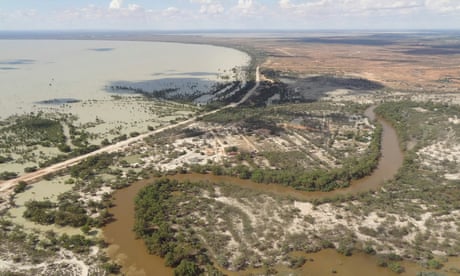- by foxnews
- 11 Mar 2025
Lethal ‘blackwater’ in Barwon-Darling river prompts fears of another mass fish kill
Lethal ‘blackwater’ in Barwon-Darling river prompts fears of another mass fish kill
- by theguardian
- 16 Feb 2022
- in news

Floodwaters carrying "blackwater" lethal to aquatic life are moving south in the Barwon-Darling river towards the Menindee Lakes, raising fears the situation may cause a repeat of events in 2019 where over a million native fish were killed.
Blackwater events are caused when heavy rains wash leaf litter that has collected on a floodplain into a major river such as the Barwon-Darling, turning it the colour of dark tea.
Australian National University (ANU) ecologist Dr Matt Colloff said they were dangerous to aquatic life as the organic compounds plants used for protection against insect attack leached out of leaf litter and dissolved into the river.
"Bacteria then break down the dissolved organic compounds and release carbon dioxide," Colloff said. "In the process of metabolising carbon, the bacteria use up the oxygen in the water."
Colloff said once concentrations of dissolved oxygen fell below about 2-3mg/L, fish suffocated because they could not draw enough oxygen from the water through their gills to survive.
As blackwater events move slowly and can stretch for kilometres, there is no way for fish and other aquatic life to swim through it. Depending on the geography of the area, they can be left with nowhere to hide as the waters approach, resulting in a mass die off.
The Menindee Lakes were hit by a mass die off in 2019 that is thought to have killed more than a million native fish, devastating stocks of bony herring, Murray cod, silver perch and golden perch.
A spokesperson for NSWWater said in a statement the blackwater had started arriving in the upper Menindee lakes at Lake Weatherell, where the Barwon-Darling enters the system.
There had been "no scope for intervention" upstream of the artificial lake system "all the way to the Queensland border", the statement said, but efforts were under way to "shandy" the blackwater by releasing fresh water into it.
"WaterNSW is releasing some of this low-quality blackwater from Lake Wetherell into the adjoining Lake Pamamaroo, where it is being diluted by better-quality water in Pamamaroo, as well as offering native fish some refuge from the worst of the blackwater.
"Exposing this water to the large surface area of Lake Pamamaroo is also intended to improve dissolved oxygen levels."
The spokesperson said the blackwater entering the system had also been aerated as it moved through the gates at Lake Weatherill and Lake Menindee, but stressed the combined efforts were not a "silver bullet".
Menindee resident Graeme McCrabb said he noticed the blackwater arrive on Friday but the action of the water passing through the weir had "broken up" the water and he did not believe a fish kill was currently a risk.
"We had, basically, oxygen levels below 1mg/L for extended periods of time - for 24, 48 hours in different sections," he said. "And anywhere in the Darling, below two is high risk of fish mortality."
The New South Wales Department of Primary Industry's and Environment was contacted for comment but did not respond to questions about oxygen readings at different stages of the river or reports of fish deaths.
Blackwater events do occur naturally when river systems restart after long dry periods, but ANU professor Jamie Pittock said these events were "a natural risk that has been accelerated by poor management".
"Every few years a flood would take the leaf litter away. It's been 10 years since the last one," Pittock said.
"It does occur naturally but the severity and frequency of these events is increasing as the environmental flows on the floodplain decrease.
"The frequency of floods is decreasing because of the excessive amount of water being taken for agriculture and because of governments failing to implement the environmental flows they promised in the 2012 environmental management plan."
Pittock said a failure to regulate floodplain harvesting had also interrupted natural flooding events.
While heavy flooding in northern NSW and south-east Queensland was causing the rivers to surge again, he said it would a mistake to treat the current situation as a "return to normal".
Climate change forecasts for the river system predict more severe droughts and floods, a process which is likely to increase the build-up of leaf litter over time.
"That is likely to exacerbate blackwater events unless we make more substantial efforts to reduce that risk where we can through managed environmental flows," Pittock said.
NSWWater said the volume of releases into the Lower Darling downstream area was gradually being reduced from 18,000 megalitres a day down to 500 megalitres a day by the start of April.
"The reduction in releases follows a prolonged period of higher releases into the Lower Darling, and is at a rate intended to maintain downstream flow while retaining as much water in the lakes at the end of the current inflow event, as required by operational regulations."
- by foxnews
- descember 09, 2016
High-end vacation resort bans children to achieve 'tranquil environment'
The Alila Marea Beach Resort, located in Encinitas, California, has announced that it's no longer accepting kids and is transitioning to an adults-only vacation spot.
read more


